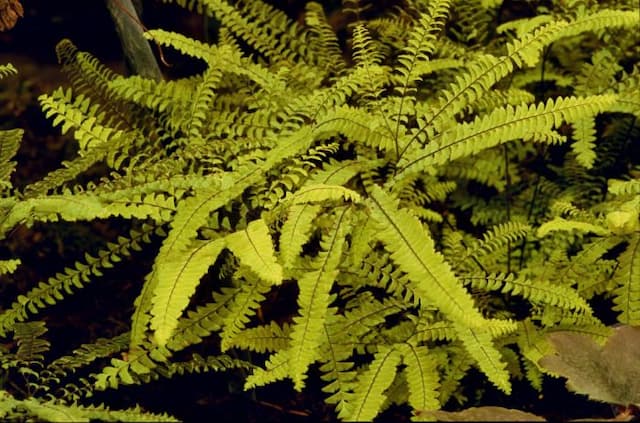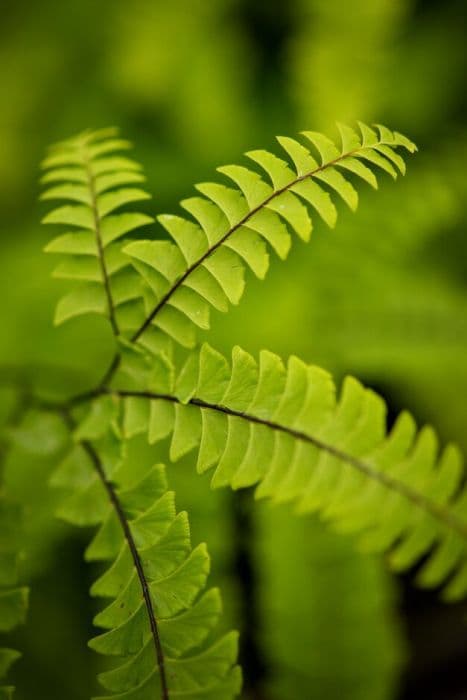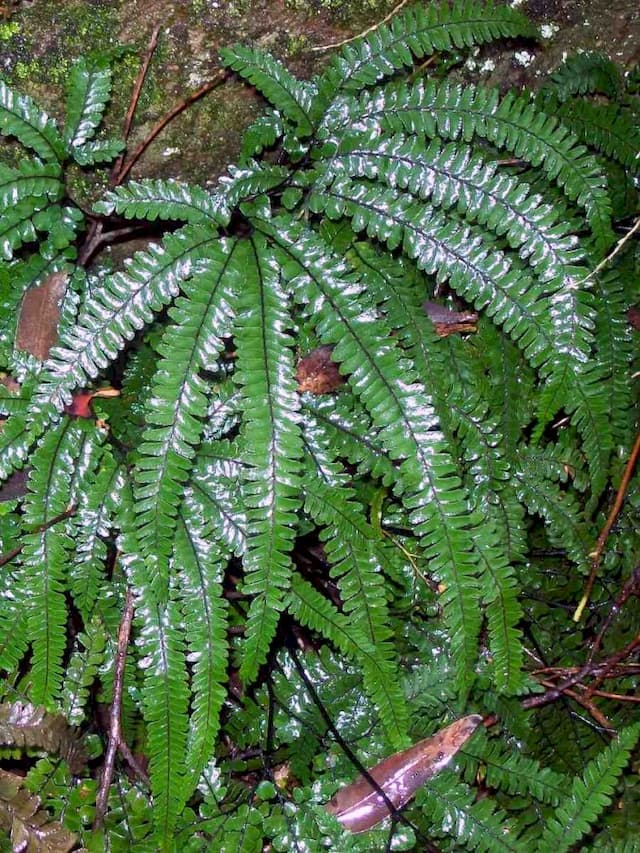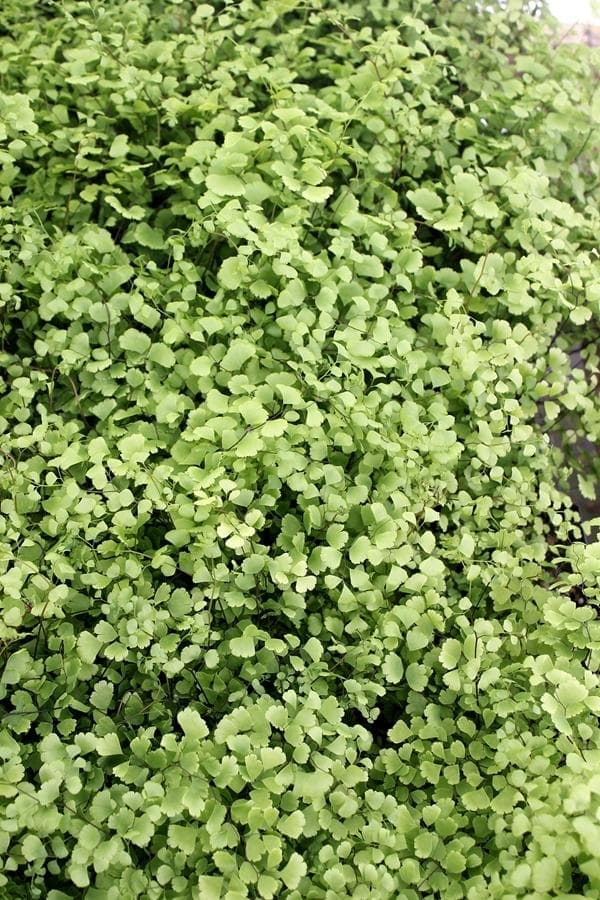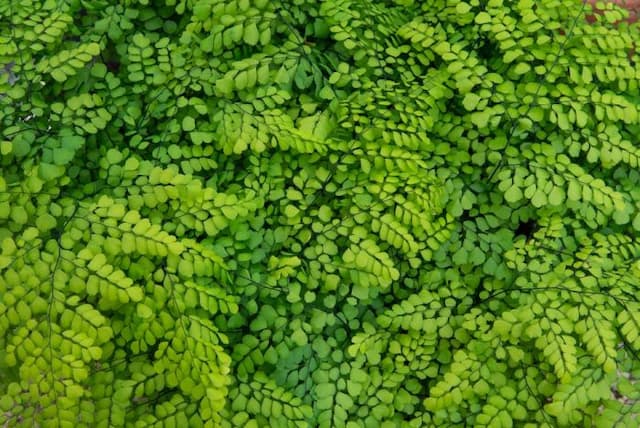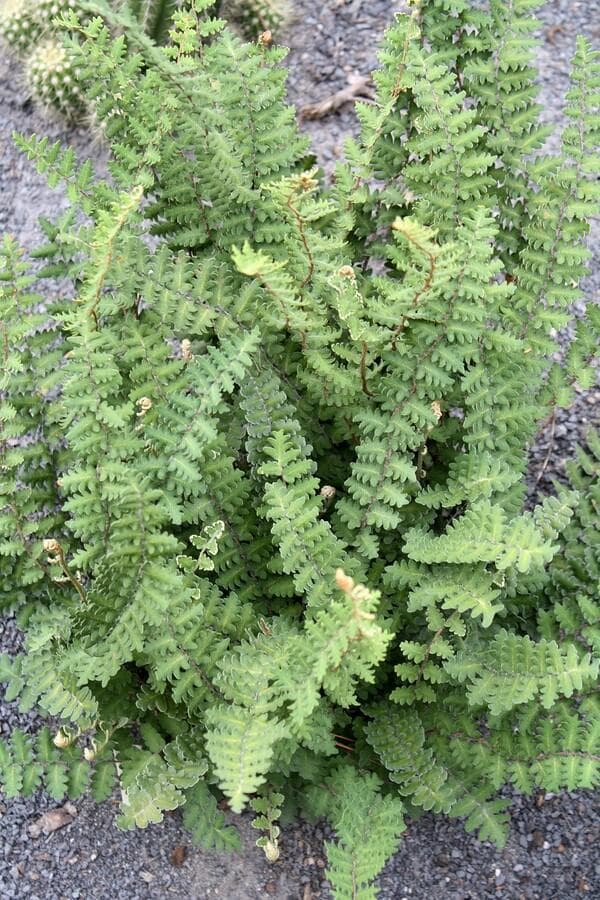Japanese Brake Fern Pteris nipponica
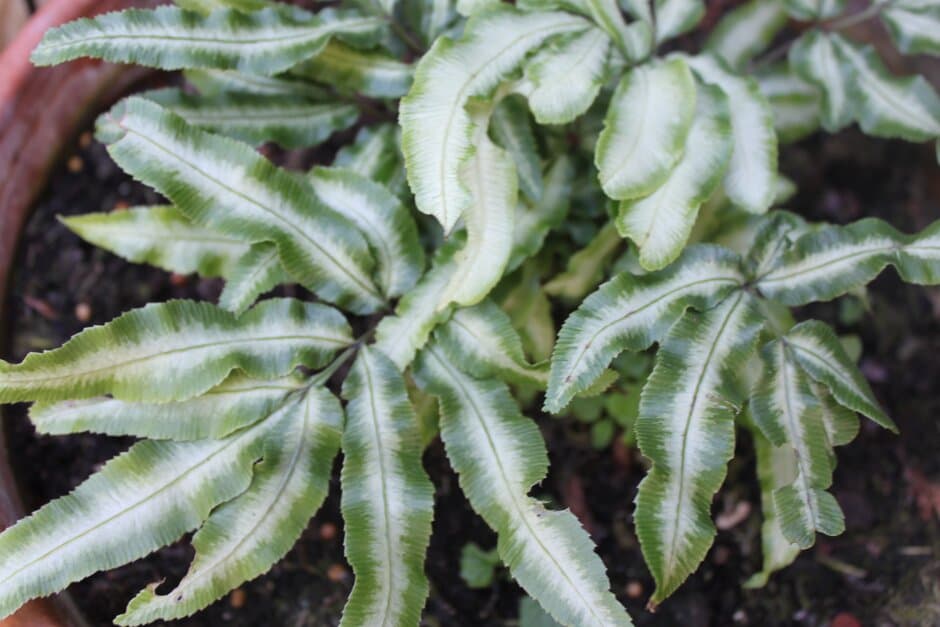
ABOUT
Pteris nipponica, often known as the Japanese brake fern, is an attractive fern with distinct physical features. It possesses a delicate and graceful foliage structure. The fronds of the Japanese brake fern are long and arching, giving them a soft and feathery look. These fronds are divided into numerous small, narrow segments that are lined up neatly along each side of the frond's central stem. The overall shape of the fronds tends to be lance-like, tapering to a pointed tip, which adds to their elegant appearance. In terms of color, the plant displays a vibrant green hue, which can add a splash of brightness to shaded garden areas or indoor spaces. The central stems, or rachises, may have a contrasting color, commonly a shade of brown, which highlights the lush green of the leaflets. The texture of the fronds is usually somewhat smooth, and the Japanese brake fern has a symmetrical growth habit that makes it attractive from all angles. It is also notable for its hardiness, being able to thrive in a variety of conditions, which makes it a popular choice for both indoor and outdoor planting. The fern doesn't flower, as ferns reproduce via spores that are often found in small clusters or lines on the underside of the fronds. These spore cases add a subtle textural detail, though they are sometimes overlooked in favor of the plant's overall frond structure and greenery.
About this plant
 Names
NamesFamily
Pteridaceae
Synonyms
Japanese Brake Fern, Nippon Fern
Common names
Pteris cretica var. nipponica
 Toxicity
ToxicityTo humans
Pteris nipponica, commonly known as the Japanese brake fern, has a level of toxicity due to its content of ptaquiloside, a potentially carcinogenic compound. Ingesting any part of the plant may lead to gastrointestinal distress, including symptoms such as nausea, vomiting, abdominal cramps, and diarrhea. Ptaquiloside can also pose a risk if consumed in large quantities over time, potentially leading to an increased risk of certain cancers. It is advisable for humans to avoid consuming any part of the Japanese brake fern.
To pets
Japanese brake fern (Pteris nipponica) may also be toxic to pets, notably because it contains ptaquiloside. If pets ingest any part of the plant, they could exhibit similar symptoms of poisoning as in humans, such as vomiting, diarrhea, and abdominal pain. Consistent or significant ingestion of the fern may elevate the risk of chronic health issues or carcinogenic effects in pets. It is important to prevent pets from consuming this plant to avoid these potential health risks.
 Characteristics
CharacteristicsLife cycle
Perennials
Foliage type
Evergreen
Color of leaves
Varies
Height
1-2 feet (30-60 cm)
Spread
1-2 feet (30-60 cm)
Plant type
Fern
Hardiness zones
9
Native area
Japan
Benefits
 General Benefits
General Benefits- Ornamental Value: Pteris nipponica, commonly known as Japanese Brake Fern, is appreciated for its delicate foliage and is often used in ornamental gardening and indoor decoration.
- Low Maintenance: Japanese Brake Fern requires relatively low care once established, making it a convenient choice for busy gardeners or those new to plant care.
- Shade Tolerance: This fern thrives in shady areas where many other plants might struggle, thus allowing for garden design in low-light conditions.
- Soil Erosion Control: Like many ferns, Pteris nipponica can help prevent soil erosion when planted in gardens, particularly on slopes or in areas with loose soil.
- Habitat Support: The plant provides habitat and food for various species of insects and animals, contributing to ecological balance.
- Humidity Tolerance: The Japanese Brake Fern is well suited to environments with high humidity, making it ideal for bathrooms or other moist areas of a home.
- Companion Planting: It can be used in companion planting to create a lush, multi-layered garden due to its texture and growth habit.
 Medical Properties
Medical PropertiesThis plant is not used for medical purposes.
 Air-purifying Qualities
Air-purifying QualitiesThis plant is not specifically known for air purifying qualities.
 Other Uses
Other Uses- Pteris nipponica, or Japanese brake fern, can be used in terrariums due to its moderate size and attractive foliage, creating a miniaturized forest landscape inside glass containers.
- The fern can be used in educational settings for studying spore reproduction and the lifecycle of ferns, making it a practical example for biology classes.
- Japanese brake fern can serve as a natural art material, where its leaves are pressed and used in crafting for embellishing bookmarks, greeting cards, or picture frames.
- It can be included in animal vivariums, especially for amphibians that require moist and shady environments, as the plant can tolerate high humidity and low light.
- The fibrous root system of Japanese brake fern can help in preventing soil erosion in shady gardens where other plants may struggle to grow.
- This fern can be utilized in floral arrangements as a filler, adding a delicate and feathery green contrast to the typically more rigid and structured flowers.
- Japanese brake fern can be used as a natural dye plant, providing a green hue to textiles and fibers when used in traditional dying processes.
- Its fronds are sometimes used in traditional cultural rituals or ceremonies in Asia, symbolizing eternal youth and sincerity.
- The fern can be part of a shade garden designed to provide a serene, green space for meditation and reflection, contributing to the creation of a peaceful environment.
- In photography, the unique texture and pattern of the Japanese brake fern can be used as a subject for macro photography, highlighting the intricate details of its leaves.
Interesting Facts
 Feng Shui
Feng ShuiThe Pteris nipponica, commonly known as the Japanese Brake Fern, is not used in Feng Shui practice.
 Zodiac Sign Compitability
Zodiac Sign CompitabilityThe Japanese Brake Fern is not used in astrology practice.
 Plant Symbolism
Plant Symbolism- Resilience: Pteris nipponica, commonly known as Japanese Brake Fern (its most common common name), can thrive under various light conditions, symbolizing adaptability and perseverance.
- Endurance: As a fern, it symbolizes the capacity to endure and sustain oneself through different life challenges.
- Eternal youth: Ferns are ancient plants and often symbolize youth and new beginnings, as they bring fresh greenery every season.
 Water
WaterThe Japanese Brake Fern, or Pteris nipponica, prefers consistently moist soil, which means watering should be done when the top inch of soil feels dry to the touch. Typically, this might mean watering every 5 to 7 days, depending on environmental conditions. Each watering should provide sufficient moisture to soak the soil throughout the pot, which may equate to approximately 16 to 32 ounces, again, depending on pot size and indoor conditions. It's vital to avoid waterlogging, so ensure any excess water can drain away freely to prevent root rot.
 Light
LightThe Japanese Brake Fern thrives best in bright, indirect light. Direct sunlight should be avoided as it can scorch the delicate fronds of the plant. A spot near a north or east-facing window, or a few feet away from a south or west-facing window with a sheer curtain to diffuse the light, would be ideal. It can tolerate some shade but too little light may lead to sparse growth and a lackluster appearance.
 Temperature
TemperatureFor the Japanese Brake Fern to grow optimally, maintaining indoor temperatures between 60 to 75 degrees Fahrenheit is recommended. It can survive in temperatures as low as 50 degrees Fahrenheit but avoid exposure to temperatures below this range as it can damage the plant. The fern is not frost-tolerant, and high temperatures above 80 degrees Fahrenheit may stress the plant.
 Pruning
PruningPruning the Japanese Brake Fern is mostly done to remove brown or dead fronds and to maintain its attractive appearance. Simply cut the undesirable fronds at the base using clean, sharp scissors or shears. This can be done at any time of year as needed, although it's often best to do substantial pruning in the spring to make room for new growth. Regularly removing damaged fronds helps to encourage healthy growth and improves air circulation around the plant.
 Cleaning
CleaningAs needed
 Soil
SoilJapanese brake fern thrives best in a well-draining soil mix composed of 2 parts peat to 1 part perlite or sand to ensure proper drainage and aeration. The pH should range between 5.5 to 6.5, slightly acidic.
 Repotting
RepottingJapanese brake fern does not require frequent repotting and can be repotted every 2 to 3 years or when it outgrows its current container, typically in the spring.
 Humidity & Misting
Humidity & MistingJapanese brake fern prefers high humidity levels, about 50-60%, to mimic its natural humid forest floor habitat.
 Suitable locations
Suitable locationsIndoor
Place Japanese brake fern in bright, indirect light and maintain high humidity indoors.
Outdoor
Grow Japanese brake fern in shaded areas and protect from strong sunlight.
Hardiness zone
10-12 USDA
 Life cycle
Life cyclePteris nipponica, commonly known as Japanese Brake or Nippon Fern, typically begins its life cycle with the dispersal of spores from the parent plant, which are carried by wind due to their lightweight nature. Once the spores land in a suitable moist and shaded environment, they germinate to produce a small, heart-shaped gametophyte known as a prothallus. The prothallus develops sex organs and, following fertilization, gives rise to a new sporophyte – the familiar leafy fern plant. This young plant gradually matures and develops fronds – the leafy branches that are divided into smaller leaflets, or pinnae, which give the fern its characteristic appearance. As the Pteris nipponica continues to grow, it enters a phase of vegetative reproduction through rhizomes, which enables the fern to spread and colonize new areas. Eventually, the mature fern produces sporangia, usually on the underside of its fronds, where spores develop and are released to start the life cycle anew.
 Propogation
PropogationPropogation time
Spring-Early Summer
Propogation: Pteris nipponica, more commonly known as the Japanese brake fern, is generally propagated through spores or by division. The most popular method is division, which is typically done in the spring. To propagate by division, carefully remove the fern from its pot and use your hands or a sharp knife to divide the clump into smaller sections, ensuring that each section has a portion of roots attached. These divisions can then be potted into individual containers filled with a well-draining potting mix. Water the newly potted ferns lightly to settle the soil around the roots and maintain consistent moisture, without allowing the soil to become waterlogged. It's important to keep the divisions in a warm, humid environment out of direct sunlight until new growth appears, signaling successful propagation.
